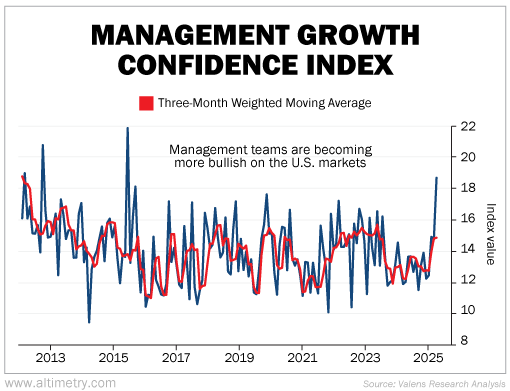The End of U.S. Deal Droughts
Editor's note: The year started with a steep drop in mergers-and-acquisitions activity. But now, U.S. companies are showing they're ready to do business again. In this issue, Joel Litman, founder of our corporate affiliate Altimetry, explains what's driving the rebound... and which sectors are poised to benefit the most.
The first quarter of 2025 looked like a deal desert...
U.S. mergers and acquisitions (M&A) hit a wall back in December. And by April, total deal volume had dropped more than 40%. That's one of the sharpest year-over-year declines in a decade.
Many blame President Donald Trump's murky economic policies...
He spent his first few months in office drawing up tariffs. That culminated in the April 2 "Liberation Day" announcement... and the most sweeping tariff hikes since the Smoot-Hawley Tariff Act of 1930.
Many of those tariffs are pending. And they didn't help cratering M&A activity.
But in May, everything changed...
Today, we'll explain why M&A deals are bouncing back... and how they might create investment opportunities in specific market sectors.
Three developments are shifting the mood in company boardrooms...
First, Trump signed Executive Order 14192 earlier this year. The order, titled "Unleashing Prosperity Through Deregulation," directs federal agencies to streamline M&A approvals across the health care, energy, and industrial sectors.
Second, the U.S. government is overhauling how agencies do business with private companies. It's revamping Federal Acquisition Regulation policies – simplifying dense language, removing non-statutory rules, and providing buying guides.
Both of these developments are sending a clear message to corporate America... The Trump administration wants to revive business deals.
Third, tariffs have become more of a bargaining tool than a genuine threat. Some have been implemented (like the 20% tariff on Taiwan)... But others have vanished due to successful trade negotiations.
All in all, Trump's tariffs have only slightly raised U.S. prices. So with less pressure from tariffs and a move toward deregulation, cash-rich businesses have sprung into action...
U.S. deal volume jumped 35% from April to June. And large, strategic acquisitions fueled that uptick...
For example, Charter Communications (CHTR) and Cox Communications announced a $35 billion merger. And software giant Salesforce (CRM) reported that it was buying AI cloud business Informatica (INFA) for $8 billion.
Bank mergers are also back on the table...
Regional and mid-tier banks, in particular, are racing to grow. That M&A pipeline has been clogged for years. So it has a backlog of buyers and sellers waiting for the green light.
And now, management teams are becoming more confident...
We can see this through the Management Growth Confidence Index, which is based on our Earnings Call Forensics ("ECF") work.
This proprietary tool helps us gauge management sentiment through vocal analysis – flagging changes in speech, tone, and more during earnings calls. We can sense management teams' confidence levels by looking at the ratio of "excitement" and "confidence" markers to "questionable" markers.
When the Management Growth Confidence Index rises, management teams are generally more bullish on their short- and medium-term outlooks. Take a look at the blue trend line below...
The three-month weighted moving average (in red) has also been trending up. It's approaching early 2023 levels after hovering near decade lows for the past 18 months.
Simply put, management teams now understand the scope of Trump's policies. And they're more optimistic that tariffs won't hamper their goals.
Importantly, the recent deal surge shows that executives are confident about the U.S. economy and their ability to generate long-term returns.
That's good news for the broad market. But a few key sectors will see the biggest opportunities...
Banking, professional services, and private equity all tend to thrive in strong M&A environments, thanks to new capital and customers. Companies focused on growth also do well.
After months of ambiguous government policies, it's clear that U.S. business leaders are finally getting some clarity... And they're ready to make big moves.
Regards,
Joel Litman
Editor's note: Joel's research has led to an elite roster of private clients – including all 10 of the world's largest investment firms. But he says he just uncovered the single biggest breakthrough in his firm's history. His new "Doubles Scanner" can instantly reveal whether your favorite stock is set to double... or about to nosedive. And until September 17, you can try this first-of-its-kind system completely free.
Further Reading
"This could be one of the biggest regulatory changes we've seen in energy," Joel writes. Utilities have long been bound by strict profit caps. But with regulators now signaling approval for record rate increases, this once-sleepy sector could be on the verge of a breakout.
The housing market has been frozen since the pandemic. But with mortgage rates nearing multiyear lows – and the Federal Reserve considering an interest-rate cut this month – a rebound could be coming. And when housing wakes up, the effects will be felt across the entire economy.


